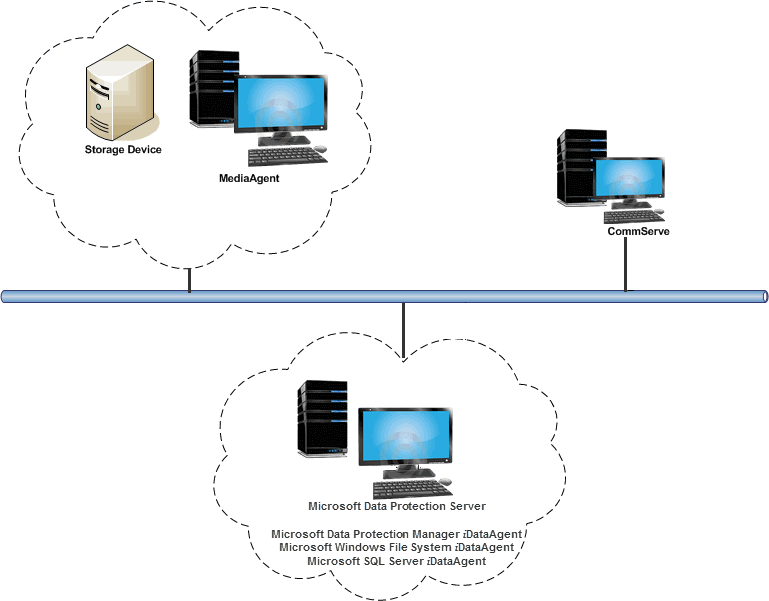
Table of Contents |
Where to go Next |
|
Database Backup and Restore Options |
Install the Microsoft Data Protection Manager iDataAgent Walks you through the process of installing the Data Protection Manager iDataAgent. |
DPM server creates and maintains replicas or full copies of a selected data sources and then synchronizes the replica with the changes that occur on the protected servers on a recurring schedule. The replica is created only once, and thereafter it is updated with the changes from the protected server. During the data replication, DPM uses Volume Shadow Copy Services (VSS) to produce snapshots of the data on the protected servers, enabling multiple point-in-time recovery points to be stored on the DPM server.
The Microsoft Data Protection Manager iDataAgent enables you to selectively back up and/or restore data that resides on the DPM Server. To provide flexible data management, the DPM iDataAgent allows backup and/or restoration of data in-place or out-of-place.
As a replica is created by DPM Server for every unique volume being protected, you need to create a subclient for each replica created. For example, if the DPM Server has 25 clients and one volume protected per client, then you need 25 separate subclients to protect them.
The Microsoft Data Protection Manager iDataAgent offers the following key features:

In the event of a serious system failure, such as the breakdown of hardware, software, or operating systems, the Microsoft Data Protection Manager iDataAgent provides point-in-time recovery of files at any given time.
The Windows File System system iDataAgent gets installed along with Microsoft Data Protection Manager iDataAgent. The system state is made up of many components and services that are critical to recovery of the Windows operating system. The system state is backed up and restored as part of Windows File System iDataAgent.
The SQL Server iDataAgent gets installed along with Microsoft Data Protection Manager iDataAgent. It provides the flexibility to backup the SQL database from different environments. You can perform a full or incremental backup of the entire instance, individual databases or files and file groups, and the transaction logs at any point of time.
Both the system and user-defined databases can be backed up. You can comprehensively backup all the databases in an instance or schedule backups for the individual databases. You can also auto-discover new databases to comprehensively manage the backup of all databases in your environment.
The SQL Server iDataAgent provides the ability to recover tables, databases or entire applications from the CommCell Console. There is no mounting, no recovery wizards, no extra steps needed – the software takes care of it all. This includes the following abilities:
In the event that a MediaAgent used for the backup or recovery operation fails, it is automatically resumed on alternate MediaAgents. In such cases, the backup or restore job will not restart from the beginning, but will resume from the point of failure. This is especially useful for backups and restores of large amount of file system data.
In the event, that a network goes down, the backup and recovery jobs are resumed on alternate data paths. Similarly, in the event of a device failure, the jobs are automatically switched to alternate disk and tape drives.
You can view and verify the status of the backup and recovery operations from the Job Controller and Event Viewer windows within the CommCell Console. You can also track the status of the jobs using reports, which can be saved and easily distributed. Reports can be generated for different aspects of data management. You also have the flexibility to customize the reports to display only the required data and save them to any specified location in different formats. For example, you can create a backup job summary report to view at-a-glance the completed backup jobs. In addition, you can also schedule these reports to be generated and send them on email without user intervention.
Deduplication provides a smarter way of storing data by identifying and eliminating the duplicate items in a data protection operation.
Deduplication at the data block level compares blocks of data against each other. If an object (file, database, etc.) contains blocks of data that are identical to each other, then block level deduplication eliminates storing the redundant data and reduces the size of the object in storage. This way dramatically reduces the backup data copies on both the disk and tapes.
The Microsoft Data Protection iDataAgent documentation uses the following terminology:
Client |
The computer in which the iDataAgent is installed and contains the data to be secured. |
BackupSet |
A group of subclients which includes all of the data backed up by the iDataAgent. |
Subclient |
The DPM Server data to be backed up. |
Metadata |
The DPM server metadata to be backed up. |